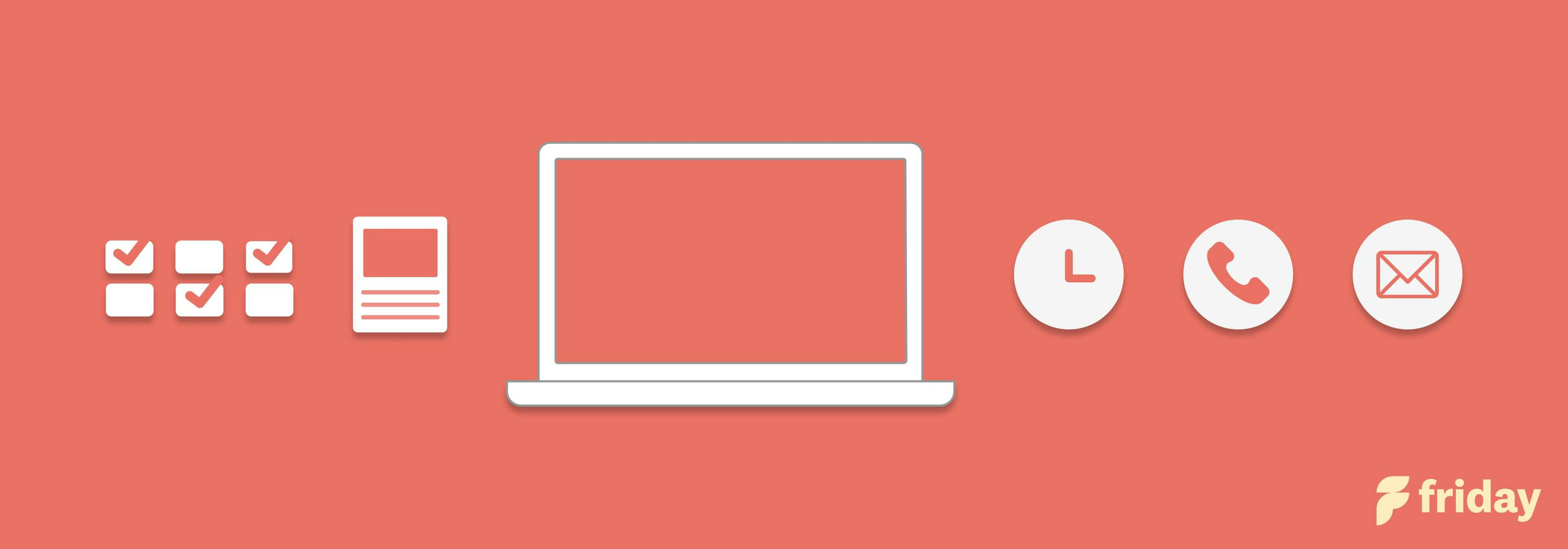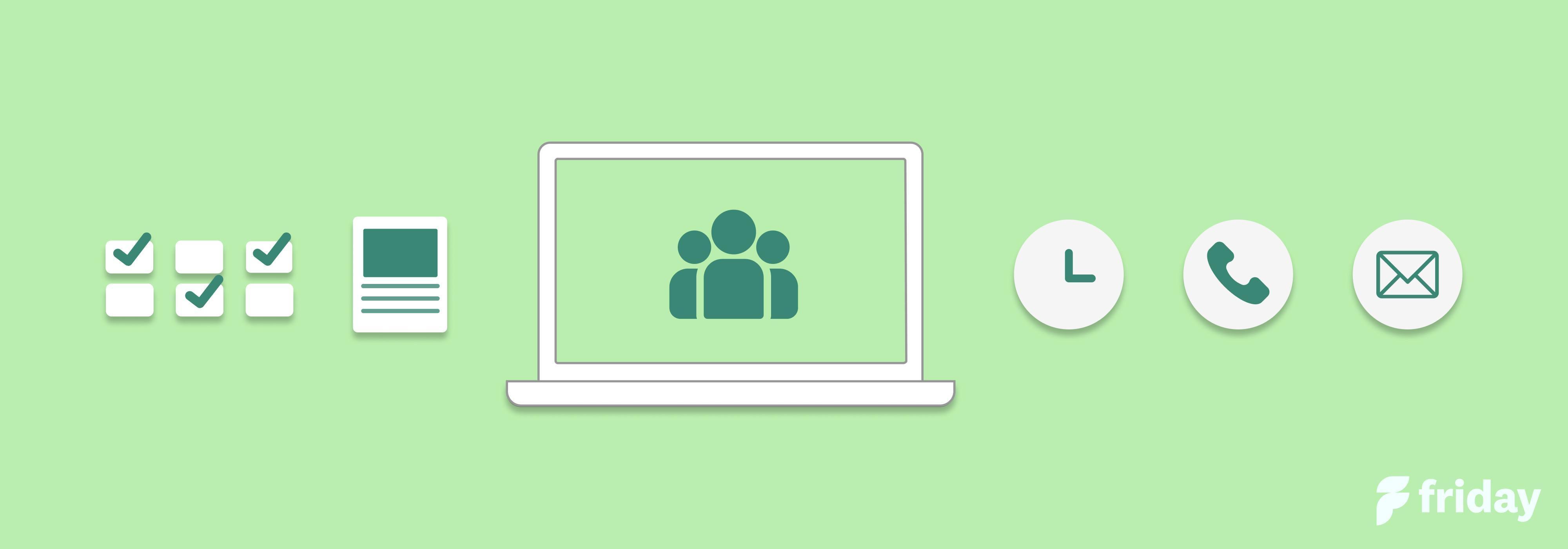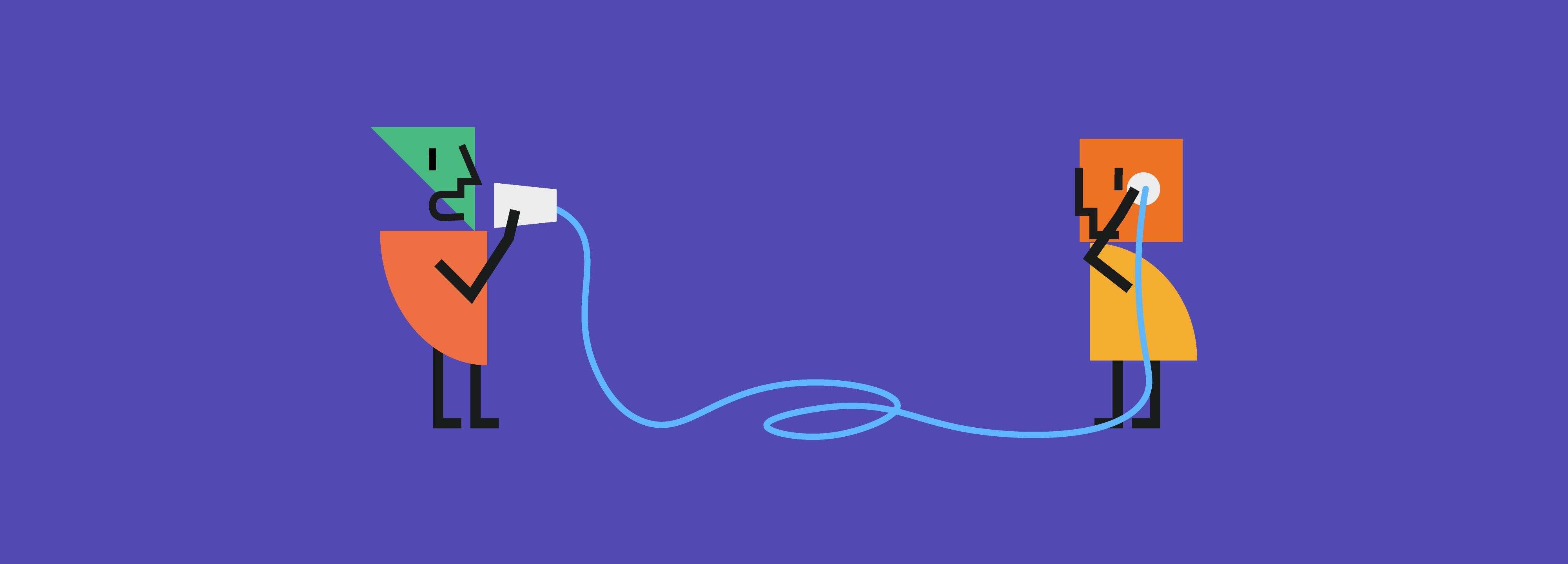Workplace Productivity: Understanding How To Improve it With Friday

Every business hopes to make more gains each year--whether that's with customers, revenue, or new products. A big factor in making that happen? Effective and productive workers. But each contribution adds up to a bigger whole--in this post, we'll explain the nuts and bolts of workplace productivity and ways you can make it better.
What is workplace productivity?
Workplace productivity is the efficiency with which you and your team work. It is a measure of how effectively you utilize your time, skills, knowledge and equipment to do the job. Productivity is a combination of the number of tasks completed, the quality of those tasks and how efficient you are, compared to your peers.
Why is workplace productivity important?
Workplace productivity is important for a couple of reasons. Happy workers are productive workers. If your employees are stressed and unhappy, they'll have a harder time producing great work. Productivity drives the success of your organization. Without it, you can't achieve your business goals and you might even fail completely.
Obviously, if you're measuring the wrong things with workplace productivity, then you'll never get results. The key is to focus on what's most important to your organization's mission: its priorities, goals, and OKRs.
Try these top workplace apps to improve your productivity.
What increases productivity in the workplace?
The biggest factor affecting productivity in the workplace is work-life balance. This means creating an environment where employees are able to have a healthy work-life balance and in which they feel motivated, fulfilled, and engaged.
To achieve this, you need to set goals that motivate your employees, provide them with the tools they need to do their jobs well, and instill a sense of pride about what they're doing. The best way to do this is by enabling them to make decisions for themselves on how things should be done. You also need to build trust among your team members so that they feel comfortable approaching you when there are problems or issues that affect their productivity.
With Friday, teams can embrace a flexible work environment that helps teams do their best work no matter where they are working.
What makes workers inefficient?
A team is productive when it can set and achieve goals. However, a team's ability to achieve goals is also influenced by its internal culture. Productivity is therefore not just about the work itself, but also the manner in which that work is done. All of this means that a productive workplace should have: Clearly defined goals. An engaged team. A healthy internal culture. Productivity isn't about working harder or longer hours; it's about getting more done by working smarter and more effectively. Productive workplaces aren't just a side-effect of happy, engaged employees; they also ensure that employees are happy and engaged because their work has value to them and to the organization as a whole.
Interruptions: It's no surprise that interruptions can kill your productivity. If you're interrupted every hour by something trivial, you'll need to spend time getting back on track.If you're lucky, the interruption might be brief and easy to handle. But a lot of interruptions are more time consuming--they require researching a problem for a co-worker, continuing conversations, and sometimes even rework.
Poor communication: If you don't know what information you need, or why it's important, you might spend far too much time and energy on irrelevant details. Also, not all information is equal. Some tasks are far more valuable than others. And if you aren't getting the right information, you're not going to be able to make the most of your time.
Multi-tasking: Most workers are asked to accomplish too many goals with too little time. Then they don’t have the bandwidth, desire, or motivation to complete these tasks in an adequate amount of time. Studies suggest multi-tasking to be up to 40% slower than working on a single task. Brains have to reset and re-orient itself after the context switching that comes with multi-tasking.
What Makes a Productive Team?
A team is productive when it can set and achieve goals. However, a team's ability to achieve goals is also influenced by its internal culture. Productivity is therefore not just about the work itself, but also the manner in which that work is done. All of this means that a productive workplace should have: clearly defined goals, an engaged team, and a healthy internal culture.
Productivity isn't about working harder or longer hours; it's about getting more done by working smarter and more effectively. Productive workplaces aren't just a side-effect of happy, engaged employees; they also ensure that employees are happy and engaged because their work has value to them and to the organization as a whole.
How Can You Help Workers Be More Productive?
Set boundaries around tech: Create time for working without distractions. Turn off your cell phone, shut off email notifications, and close your block your social media sites. You'll find that you get more done when your focus isn't scattered by the constant distraction of technology.
Improve your email habits: Clear out your inbox. Set aside time every day to go through and answer the emails that require a response. Delete the messages that aren't important. Block specific times in your calendar to view emails instead of every time one is received.
Less meetings: Meetings, as a general rule, get in the way of productivity. They often have too many attendees, so there's too much time spent on small talk. They also take place at a specific time and location, which means that you need to plan for them--and often reschedule them when they don't go as planned.
In Friday, you can cut your number of meetings in half. Many of your routine meetings can quickly be done via text or short updates, such as a daily stand-up or weekly check-in. These meetings are important for remote teams, but can be done asynchronously. Friday has question prompts for you to start with, or you can customize your own.
Reduce Distractions: Reduce distractions at the office and work from home when possible. Set yourself up for success by creating a productive workspace. Try to set up your home office in a spare room or area of your house where you can control the level of distractions. Use the Friday planner and Chrome extension to set Focus Time during your workday. When you enable Focus Time, you mute Slack notifications, and block distracting websites. You pick the ones that you want to block, and then you’ll get a friendly redirect if you try and browse that site.
Flexible work: Create a flexible work schedule so you can work when you're most productive. You'll want to make sure that your team is on the same page so that everyone understands how to proceed. It's also important to have a backup plan if someone doesn't pull their weight. Flexible work schedules are more effective in remote work, where this is an expectation that working hours will be more varied.
Set realistic goals: You need to make sure that the goals you set for yourself are realistic and obtainable. You'll want to start by having a realistic workload and then set goals based off of that. With these goals, you can track your progress and feel good about your time management.
How many hours at work are productive?
Most people will tell you that the average office worker spends around 23 hours per week on productive work. This comes from a study conducted by Salary.com which found that the average employee spends 46% of their work time on unproductive activities, which include checking social media, reading news stories, and surfing the internet. The results suggest that employees spend an average of 23 hours on productive tasks like answering emails and communicating with colleagues. However, there is a wide range between different industries with employees in healthcare spending up to 36% of their time on productive tasks while those in construction and mining spend a mere 13%.
Bonus: Check out the top productivity tools for construction management.
Does time at work mean more productivity?
Workers who feel engaged at work are more productive than those who do not. In fact, a Gallup study found that an engaged workforce is 12 percent more productive than those who are actively disengaged or dissatisfied. Furthermore, engaged employees have higher overall well-being and job satisfaction. Engaged employees may also be more productive because they tend to be more optimistic and enthusiastic, which can improve their overall well-being.
What is workplace productivity and how can it be measured?
Workplace productivity is the amount of value a person or team generates in a given period of time, typically measured in terms of units produced per unit of time.
In a manufacturing environment, for example, it might be measured in terms of pieces produced per hour. In an office environment, it might be measured in terms of sales calls made or emails sent per hour. In some cases, it might be measured in terms of a percentage of time wasted.
Workplace productivity is a combination of two factors: efficiency and effectiveness.
Efficiency refers to how well you're able to get work done in the amount of time you have available. Effectiveness refers to the quality of your work (e.g., how many errors were made or how much value was created).
The most common ways to measure workplace productivity are through output-based measures, such as number of calls completed or emails sent per hour, and input-based measures, such as hours worked per day or total number of hours worked per week.
How Friday Can Help Your Workplace Productivity
Friday is a planner and async operating system for your most important things at work.
You'll see your meetings, to-do list, and daily check-in routines in one central place, from tools you're already familiar with, like Google Calendar, Outlook, Zoom, Asana, Trello, and more. With integrations all these apps, you get a clear roadmap of your day and you can be your most productive self.
Friday automates team updates, provides routines and check-ins that replace meetings, and helps teams feel connected while avoiding another meeting. Your team will have a solution that they love to use, while also integrating with your specific tech stack, including team communication, calendars and project management tools.
Teams get access to handbooks, kudos, and icebreakers which helps with creating remote team culture and replicates elements of watercooler conversations.
1. Stay in sync
Automate routine updates like daily stand-ups or weekly updates. You'll have more efficient meetings.
2. Stay aligned
Align daily work to the big picture and make sure everyone knows what the most important priorities are.
3. Stay connected
Say thanks, answer icebreaker questions, and get to know your coworkers.


